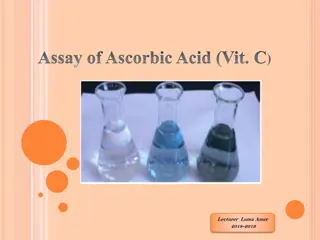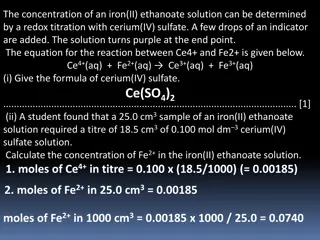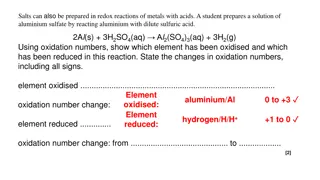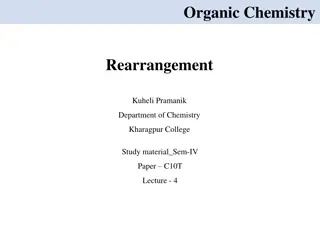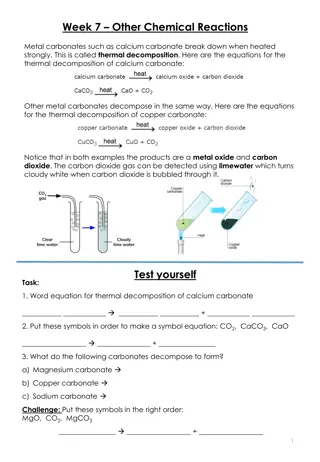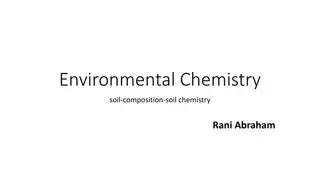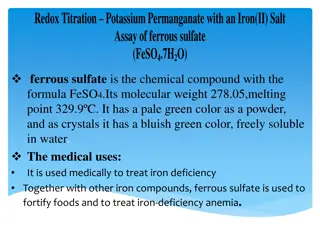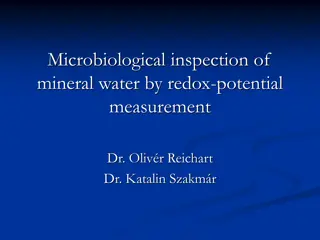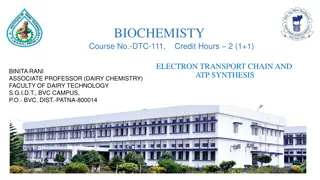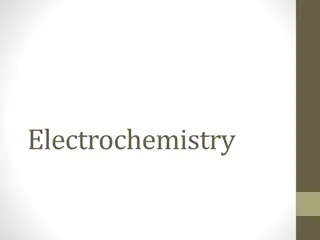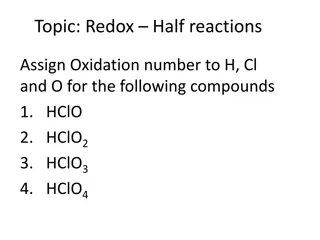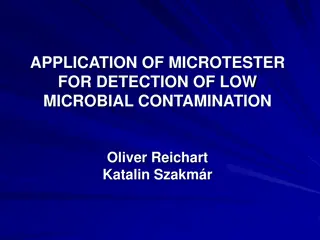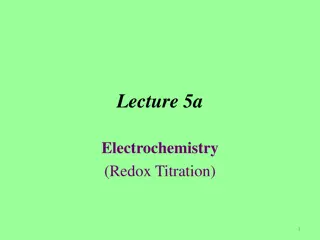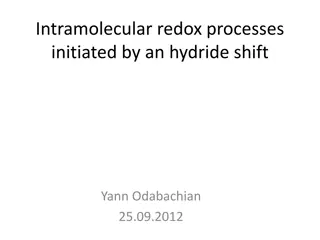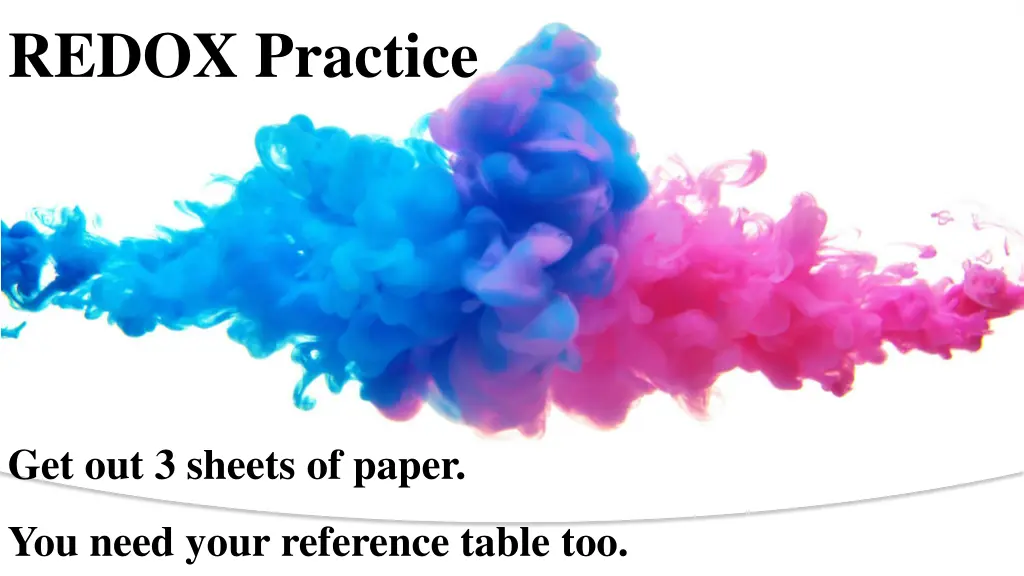
Aluminum Chloride Synthesis Reaction and Redox Practice
Explore the synthesis reaction of aluminum and chlorine to form aluminum chloride, a redox reaction. Learn to balance the reaction, assign oxidation numbers, identify oxidation and reduction, write half-reactions, and derive the net ionic equation. Enhance your understanding of redox chemistry with practical examples.
Download Presentation

Please find below an Image/Link to download the presentation.
The content on the website is provided AS IS for your information and personal use only. It may not be sold, licensed, or shared on other websites without obtaining consent from the author. If you encounter any issues during the download, it is possible that the publisher has removed the file from their server.
You are allowed to download the files provided on this website for personal or commercial use, subject to the condition that they are used lawfully. All files are the property of their respective owners.
The content on the website is provided AS IS for your information and personal use only. It may not be sold, licensed, or shared on other websites without obtaining consent from the author.
E N D
Presentation Transcript
REDOX Practice Get out 3 sheets of paper. You need your reference table too.
Copy Aluminum and chlorine form aluminum chloride(synthesis reaction, also redox)
Aluminum and chlorine form aluminum chloride(synthesis reaction, also redox) Al(S) + Cl2(G) AlCl3(S) balance this now
Aluminum and chlorine form aluminum chloride(synthesis reaction, also redox) 2Al(S) + 3Cl2(G) 2AlCl3(S) add oxidation numbers
Aluminum and chlorine form aluminum chloride(synthesis reaction, also redox) 2Al (S) + 3Cl2 (G) 2Al+3Cl3 1(S) All atoms have a zero-oxidation number, their protons = electrons, no charge Ionic compounds have ionic charges. Each Al is +3, so you NEED 3 Cl which are 1. The whole ionic compound is neutral, but its parts are charged.
Aluminum and chlorine form aluminum chloride(synthesis reaction, also redox) 2Al (S) + 3Cl2 (G) 2Al+3Cl3 1(S) Decide what changes, what becomes MORE positive (loses electrons) oxidizes? What becomes more negative (gains electrons) reduces?
Aluminum and chlorine form aluminum chloride(synthesis reaction, also redox) 2Al (S) + 3Cl2 (G) 2Al+3Cl3 1(S) The aluminum atoms become more positive; they are oxidized into Al+3 cations. The chlorine atoms become more negative; they are reduced into Cl 1 anions.
Aluminum and chlorine form aluminum chloride(synthesis reaction, also redox) 2Al (S) + 3Cl2 (G) 2Al+3Cl3 1(S) Write out the two half reactions OX RED
Aluminum and chlorine form aluminum chloride(synthesis reaction, also redox) 2Al (S) + 3Cl2 (G) 2Al+3Cl3 1(S) OX 2Al 2Al+3 + 6e RED 3Cl2 + 6e 6Cl 1 Write out the NET ionic equation
Aluminum and chlorine form aluminum chloride(synthesis reaction, also redox) 2Al (S) + 3Cl2 (G) 2Al+3Cl3 1(S) OX 2Al 2Al+3 + 6e RED 3Cl2 + 6e 6Cl 1 NET 2Al + 3Cl2 2Al+3 + 6Cl
Again. Put zinc metal into a copper I chloride solution.
zinc metal into a copper I chloride solution. Zn(S) + CuCl(AQ) ZnCl2(AQ) + Cu(S) Now balance this
zinc metal into a copper I chloride solution. Zn(S) + 2CuCl(AQ) ZnCl2(AQ) + 2Cu(S) Now put in the oxidation numbers.
zinc metal into a copper I chloride solution. Zn (S) + 2Cu+1Cl 1(AQ) Zn+2Cl2 1(AQ) + 2Cu (S) Now determine, which is getting more positive, which is getting more negative?
zinc metal into a copper I chloride solution. Zn (S) + 2Cu+1Cl 1(AQ) Zn+2Cl2 1(AQ) + 2Cu (S) The zinc goes from a 0 +2 oxidation number, Zn is oxidized. The 2Cu+1goes from +1 0, it gets less positive, 2Cu+1 is reduced. The chloride Cl 1 anions are the spectator ions.
zinc metal into a copper I chloride solution. Zn (S) + 2Cu+1Cl 1(AQ) Zn+2Cl2 1(AQ) + 2Cu (S) Write the half reactions and the net ionic equation now
zinc metal into a copper I chloride solution. Zn (S) + 2Cu+1Cl 1(AQ) Zn+2Cl2 1(AQ) + 2Cu (S) OX Zn Zn+2 + 2e RED 2Cu+1 + 2e 2Cu NET Zn + 2Cu+1 Zn+2 + 2Cu
Again. Put aluminum metal into lead (IV) nitrate solution
aluminum metal into lead (IV) nitrate solution Al(S) + Pb(NO3)4(AQ) Al(NO3)3(AQ) + Pb(S) Note the +4 ion up front, and a +3 in the products! Think, don t fudge it! Carefully balance this reaction.
aluminum metal into lead (IV) nitrate solution 4Al(S) + 3Pb(NO3)4(AQ) 4Al(NO3)3(AQ) + 3Pb(S) now squeeze in the oxidation numbers.
aluminum metal into lead (IV) nitrate solution 4Al (S) + 3Pb+4(NO3)4 1(AQ) 4Al+3(NO3)3 1(AQ) + 3Pb (S) Decide what is oxidizing and what is reducing, and what s spectating.
aluminum metal into lead (IV) nitrate solution 4Al (S) + 3Pb+4(NO3)4 1(AQ) 4Al+3(NO3)3 1(AQ) + 3Pb (S) 4Al is becoming more positive, it s oxidizing. 3Pb+4 becomes less positive, it s being reduced. The nitrates are the spectator ions. Write the half reactions and the net ionic equation.
aluminum metal into lead (IV) nitrate solution 4Al (S) + 3Pb+4(NO3)4 1(AQ) 4Al+3(NO3)3 1(AQ) + 3Pb (S) OX 4Al (S) 4Al+3 + 12e RED 3Pb+4 + 12e 3Pb NET 4Al + 3Pb+4 4Al+3 + 3Pb
Label this electrolytic cell. We will plate platinum metal onto the aluminum ring. The solution is platinum (IV) chlorate. Note, I turned this around, so you must also turn around the battery, make sure the electrons end up on the ring, or else! Then write the half reactions and the net ionic equation.
Battery Voltaic Cell OX Pt Pt+4 + 4e OX RED RED Pt+4 + 4e Pt anode NET Pt + Pt+4 Pt + Pt+4 Pt Pt+4 Pt Al does not participate. Al ClO-1 Platinum plates onto the aluminum cathode
Label this completely, show arrows in solutions, electron flow arrows, ion flow arrows, solution charges and solution charges becoming net zero, label anode and cathode, then write 2 half reactions, a net ionic equation, and name 3 reasons this voltaic cell stops producing electricity. FAST. At left, lithium metal in a lithium nitrate solution. At right, nickel metal into a nickel (III) chlorate solution. The salt bridge is sodium chloride.
NaCl(AQ) e + Li Ni Ni+3 Li+1 RED OX OX is on the left (lithium higher than nickel on table J) Show flow of electrons from Li electrode to nickel electrode. Solutions get charged instantly (this is bad).
Na+1 Cl-1 e + Li Ni Ni+3 Li+1 RED OX Sodium ions migrate to the left beaker, making the negative solution neutral again. Chloride anions migrate to the right beaker, making the positive solution neutral again. The metal bars are the anode and cathode. Leo is a RED CAT!
Anode CAThode Na+1 Cl-1 e + Li Ni Ni+3 Li+1 RED OX Sodium ions migrate to the left beaker, making the negative solution neutral again. Chloride anions migrate to the right beaker, making the positive solution neutral again. The metal bars are the anode and cathode. Leo is a RED CAT!
Anode Cathode Na+1 Cl-1 e + Li Ni Ni+3 Li+1 RED OX OX 3Li 3Li+1 + 3e Battery dies when it runs out of RED Ni+3 + 3e Ni Anode Cathode side cations Salt ions NET 3Li + Ni+3 3Li+1 + Ni

